 Pew Research Center recently looked at the data from their 2014 Religious Landscape Study to highlight the affiliations, demographics, religious practices and political beliefs of various religious groups in the United States.
Pew Research Center recently looked at the data from their 2014 Religious Landscape Study to highlight the affiliations, demographics, religious practices and political beliefs of various religious groups in the United States.
Here are seven figures you should know from the report:
1. The group that leans most heavily toward the Republican Party is Mormons. Seven-in-ten U.S. Mormons identify with the party or say they lean toward the GOP, compared with 19% who identify as or lean Democratic — a difference of 51 percentage points.
2. The group that leans most heavily toward the Democratic Party is the African Methodist Episcopal (AME) Church. Almost all (92 percent) identify with or lean toward the Democratic Party, while just 4 percent say they favor the Republican Party — a difference of 88 percentage points.
3. Two other historically black denominations also identify almost exclusively with Democrats: 87 percent of members of the National Baptist Convention and 75 percent of members of the Church of God in Christ.
4. White evangelical Protestants tend to favor the Republican Party. Members of the Church of the Nazarene are overwhelmingly likely to favor the GOP (63 percent Republican vs. 24 percent Democrat), as are the Southern Baptist Convention (64 percent vs. 26 percent) and the Lutheran Church-Missouri Synod (59 percent vs. 27 percent), among other evangelical churches.
5. Catholics are divided politically, with 37 percent saying they favor the GOP and 44 percent identifying with or leaning toward the Democratic Party (another 19 percent say they do not lean either way).
6. Mainline Protestant churches vary in their support. Some, like the United Methodist Church, lean toward the GOP (54 percent vs. 34 percent), while others, like United Church of Christ, heavily favor Democrats (58 percent vs. 31 percent).
7. All three subsets of religious “nones” (atheists, agnostics and those who say their religion is “nothing in particular”) lean toward Democrats (49 percent vs. 26 percent).

